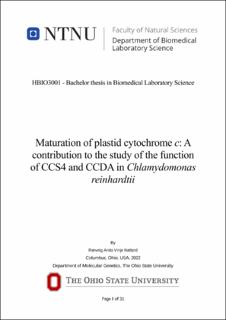| dc.contributor.advisor | Prestvik, Wenche Slettahjell | |
| dc.contributor.advisor | Das, Ankita | |
| dc.contributor.advisor | Hamel, Patrice | |
| dc.contributor.author | Natland, Ranveig Anita Vinje | |
| dc.date.accessioned | 2022-07-12T17:20:21Z | |
| dc.date.available | 2022-07-12T17:20:21Z | |
| dc.date.issued | 2022 | |
| dc.identifier | no.ntnu:inspera:106147449:107341459 | |
| dc.identifier.uri | https://hdl.handle.net/11250/3004834 | |
| dc.description.abstract | | |
| dc.description.abstract | Cytochromes c are electron carrier proteins with a heme group covalently attached to a CXXCH motif. In the plastid, cytochromes c are involved in photosynthesis and their assembly requires the attachment of heme to the cysteines in the motif, a reaction happening in the thylakoid lumen and controlled by assembly proteins called CCS (Cytochrome C Synthesis). The proteins CCDA, CCS4 and CCS5 are required to reduce the disulfide bonded CXXCH motif prior to heme ligation. CCDA and CCS5 are thylakoid-bound proteins that transfer electrons from stroma to lumen to directly reduce the disulfide bonded CXXCH via conserved cysteines. CCS4 is a thylakoid-bound protein facing the stroma whose function is unclear because there is no cysteine or motif indicating the protein can transfer electrons. To further study the role of CCS4 in the maturation pathway, we aimed to identify interacting proteins via immunoprecipitation. Transformants producing a tagged CCS4 with 2 or 3 copies of the HA tag in the C-terminal part of the protein were generated and analyzed molecularly for the presence of the tag. Phenotypic analysis showed that such transformants are wild-type like with respect to cytochrome c assembly and photosynthetic growth, an indication that the tag does not disrupt the function of CCS4. However, first attempts to detect the CCS4-HA protein using an anti-HA antibody were unsuccessful. We also attempted to create a CCDA knock-in mutant using CRISPR/Cas9 technology as there is currently no ccda mutant in Chlamydomonas reinhardtii. Preliminary results showed that the guide RNAs can cleave the CCDA template in an in vitro reaction. An insertional cassette conferring resistance to Hygromycin B was generated via PCR for the CCDA knock-in. Optimization is in progress to enhance the yield of the amplicon, a necessary improvement generating the CCDA mutation using Cas9 in vivo. | |
| dc.language | eng | |
| dc.publisher | NTNU | |
| dc.title | Maturation of plastid cytochrome c: A contribution to the study of the function of CCS4 and CCDA in Chlamydomonas reinhardtii | |
| dc.type | Bachelor thesis | |
